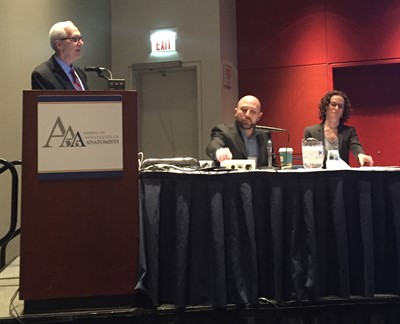NUHS Dean of Research Gregory Cramer, DC, PhD, and alum Joshua Little, DC, PhD, discussed the mechanisms of low back pain and spinal manipulation as a non-pharmaceutical approach to its treatment at Experimental Biology (EB), a major national scientific conference last month.
 The presentations were the accumulation of over 40 years of research. Dr. Cramer has been studying how decreased joint motion can cause adhesions between joints and how spinal manipulation can break up those adhesions and re-establish joint motion. Over the last decade, his research has been published in multiple journals and presented as posters at previous EB conferences. Dr. Little, a faculty member at Saint Louis University School of Medicine, has focused his research on the neurological changes that occur in the spinal cord and the brain to promote pain states. He has published articles on pain research in several journals, most notably the high impact journal Brain.
The presentations were the accumulation of over 40 years of research. Dr. Cramer has been studying how decreased joint motion can cause adhesions between joints and how spinal manipulation can break up those adhesions and re-establish joint motion. Over the last decade, his research has been published in multiple journals and presented as posters at previous EB conferences. Dr. Little, a faculty member at Saint Louis University School of Medicine, has focused his research on the neurological changes that occur in the spinal cord and the brain to promote pain states. He has published articles on pain research in several journals, most notably the high impact journal Brain.
At the EB conference, Dr. Little and Dr. Cramer were joined by Laura Stone, PhD, a researcher from McGill University’s Alan Edwards Centre for Research on Pain. They each discussed their respective research related to low back pain as part of an hour-and-a-half long symposium. “It was a tremendous honor,” Dr. Cramer said. “The symposium was well-attended and generated much discussion afterward.”
Hosted by various associations and societies in anatomy, physiology, biochemistry, pathology, nutrition and pharmacology, the annual conference was attended by over 14,000 researchers and featured the latest research in the biomedical and clinical sciences.
The EB symposium was timely, as low back pain is now considered the primary cause of global disability. The low back pain symposium was highlighted to EB conference attendees, likely because of this global burden as well as the recent attention in the media and scientific community to the importance of non-pharmacologic approaches for the treatment of back pain, which includes the recommendation of spinal manipulation.
In February, the American College of Physicians updated its guidelines for treating low back pain, first recommending non-drug therapies like spinal manipulation before the use of medications. The Journal of the American Medical Association (JAMA), a major medical journal, also published a recent study that supports spinal manipulation therapy for effectively alleviating low back pain, which remains a common problem not only among Americans, but throughout the world.
When Dr. Cramer first started his research, there was no evidence supporting the hypothesis that less joint movement (i.e., hypomobility) altered the structure and function of the spinal Z joints. Through his fundamental research approaches, Dr. Cramer demonstrated that hypomobility causes adhesions and degenerative changes in the Z joint, while spinal manipulation induces Z joint motion by separating the joint surfaces, which may break up the adhesions to re-establish joint motion. “While in private practice, I saw how spinal manipulation benefited my patients firsthand,” Dr. Cramer said. “This motivated me to begin doing research on the subject at National University.”
During the EB conference symposium, Dr. Cramer specifically discussed the biology of the spinal facet (zygapophyseal or “Z”) joints and the clinical implications of spinal manipulation on the joints.
Dr. Little chaired the symposium and spoke on his work studying spinal osteoarthritis and the spinal cord mechanisms underlying low back pain. Dr. Stone’s presentation focused on her work using preclinical animal models of intervertebral disc degeneration associated with pain.
In the coming months, Drs. Cramer, Little, and Stone will continue to perform experiments, publish their research on low back pain in academic journals, and apply for grants to perform additional research to address the global problem of low back pain.
“It is promising to see all the research and developments that have taken place supporting spinal manipulation since I began researching the topic,” Dr. Cramer said. “More research will add to this growing body of knowledge.”
National University is proud to have faculty and graduates at the forefront of research in back pain and spinal manipulation. NUHS continues to help fill the need for non-opioid and alternative treatments through chiropractic medicine, naturopathic medicine, oriental medicine and massage therapy.




0 Comments